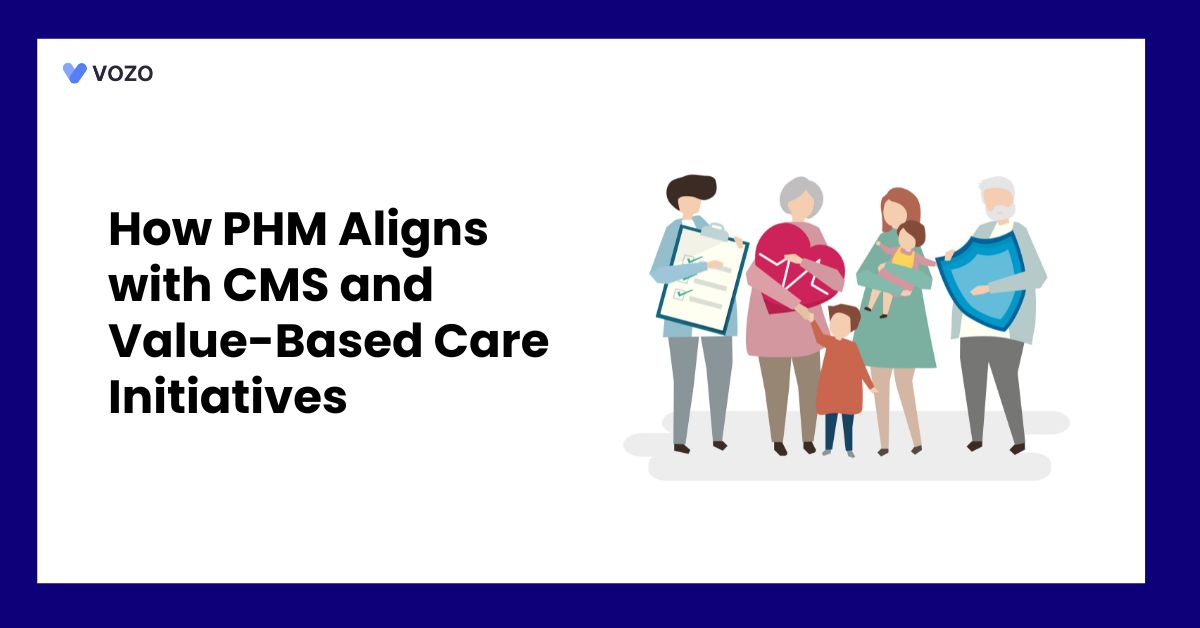How Population Health Management Aligns with CMS and Value-Based Care Initiatives
The healthcare industry is constantly changing to value-based care. Instead of getting reimbursements for every test and patient visit, healthcare providers and hospitals are now getting paid for keeping the patients healthy and to avoid unnecessary treatments. This strategic approach is called value-based care.
To make it work, providers need tools to understand and manage the health of groups of people. This is where population health management comes in. PHM helps providers to spot patients at risk beforehand, coordinate care better, and track results over time.
In this blog post, we have shared how PHM supports the goals of value-based care and how it works with CMS programs like Medicare and Medicaid.
What is Population Health Management?
Population health management is a concept of managing care across general populations or a group of individuals. The main goal of PHM is to gather, normalize, and analyze clinical data of patients from across all healthcare systems that can reveal better opportunities to improve patient health financial outcomes for healthcare providers.
PHM can assist clinicians, patients, and insurers in:
- Gathering
- Exchanging
- Analyzing patient data to coordinate care
- Promote wellness through evidence-based decision support in clinical care
By combining clinical care with healthcare economics and outcomes assessment. PHM requires advanced technologies that assist in data aggregation, data governance, and data analytics.
The system must also enable the reporting capabilities required for compliance and provider incentives. In the United States, PHM is often linked to incentives that demand a provider to statistically demonstrate an improvement in a certain population’s health.
Related: The Role of EHRs in Value-Based Care and Population Health Management
Key Ways PHM Aligns with CMS and Value-Based Care
Population health management is a strategic approach to improve health outcomes for a group of individuals. But how does it align with CMS and value-based care?
1. Data-Driven Decision Making
Healthcare practitioners utilize optimizing treatment plans and improving health outcomes by combining patient data from diverse healthcare systems, such as EHRs, patient reports, and wearable devices.
Using this information, providers will decide how to care for patients rather than guessing or waiting until someone becomes critically ill. This strategy is consistent with the Centers for Medicare & Medicaid Services and Value-Based Care, as both aim to improve patient health while lowering costs.
For instance:
- A healthcare facility analyzes the data and discovers that many diabetic patients do not go to the hospital for routine check-ups.
- Using this crucial information, clinics can now contact diabetic patients, schedule appointments, and assist them in better managing their diseases.
- This reduces problems, enhances patient outcomes, and saves money.
2. Chronic Disease Management
Chronic disorders such as high blood pressure, diabetes, and heart disease necessitate continual monitoring of vital signs to stay healthy.
PHM uses data to help them prevent difficulties before they occur, rather than waiting for patients to become ill and be admitted to the hospital.
But how does it align with CMS and value-based care?
- CMS rewards clinicians who help patients stay healthy. PHM helps providers to detect and manage chronic diseases at an early and consistent stage.
- Population health management lowers overall healthcare costs by reducing emergency visits and hospital stays, and it is strongly supported by value-based care.
- PHM encourages communication among providers, specialists, and care teams, which is critical for CMS-led initiatives like Accountable Care Organizations.
- Chronic care is highly personalized, including regular check-ins, lifestyle coaching, and digital monitoring tools.
- This aligns with the value-based care strategy, which prioritizes patient needs.
3. Care Coordination Across Providers
Care coordination is all about healthcare providers, specialists, nurses, and care teams who are all involved in patient care, coordinators can deliver care quality.
They share patient health information, treatment plans, and progress updates. This is to make sure that the patients receive the right care at the right time.
- Usually, large scale hospitals might have failed with interoperability.
- So that providers from various departments might not have access to updated patient information.
- This gap can lead to delays in treatments.
Population health management aims to keep patients from sliding through these gaps when they transition between treatment settings. When doctors share patient information, there is less risk of repeat tests, contradictory prescriptions, or missed follow-ups.
CMS-managed programs such as ACOs and PCMHs rely on coordinated care to enhance outcomes and eliminate wasteful expenses.
PHM systems help with coordination by sharing patient data, tracking treatment plans, and encouraging teamwork across the care network.
4. Patient Engagement and Education
To enhance outcomes, patients must take an active role in their health. Providers use a population health management system to educate patients about their medical issues, treatments, and healthy practices.
- Patients who are well-educated and engaged are more likely to stick to their treatment plans, manage chronic diseases, and stay out of the hospital.
- When people have a better awareness of their health, they may make more informed choices. This often results in fewer emergency visits and more expensive procedures.
- CMS encourages preventative care, chronic disease management, and patient satisfaction. All of which improve with strong engagement and education strategies.
For example, providers utilize PHM platforms to send reminders, provide health suggestions, track patient progress, and encourage lifestyle changes, all to keep people healthier and avoid unnecessary treatment.
5. Meeting Quality Metrics and Reporting Standards
The CMS and value-based care programs measure how well clinicians care for their patients, not how many services they deliver.
PHM platforms collect and analyze data from many sources, allowing providers to understand how they’re doing on key measures such as controlling chronic diseases, reducing hospital readmissions, and ensuring patients receive preventive care.
By meeting these quality benchmarks and reporting them accurately, providers can:
- Show they’re giving high-quality care
- Earn financial incentives from CMS
- Avoid penalties
- Improve patient outcomes
Related: The Step-by-Step Guide to Building a Successful Population Health Program
Vozo Cloud EHR for Population Health Management
If you are searching for the best EHR system for your healthcare practice, Vozo EHR can be your go-to choice. Our comprehensive EHR solution lets you focus more on patient care while carrying all the burdens and simplifying it.
- Vozo Cloud EHR’s cost-effective cloud subscription benefits all levels of practice.
- Our feature-rich EHR helps you rectify mistakes efficiently and speed up the process.
- Vozo Specialty EHR resonates with specialty practice needs and requirements.
- Our expert technical team got you covered 24/7 if any needs arise.
- Our EHR System continues to scale as your healthcare practice grows to improve the user experience.
The Vozo Customized EHR solution benefits your healthcare practice by:
- Streamlining the administrative process
- Improving workflow efficiency
- Reducing proneness to errors
- Manages all the patients’ records in one place
- Offers greater efficiency and cost savings across the board.
Our specialty-specific tools, such as scheduling, patient portals, lab integration, cloud hosting, and more, meet your healthcare practice’s specific needs and requirements.
“Embrace Vozo EHR to Reduce Your Burdens and Enhance Patient Care”.
About the author

With more than 4 years of experience in the dynamic healthcare technology landscape, Sid specializes in crafting compelling content on topics including EHR/EMR, patient portals, healthcare automation, remote patient monitoring, and health information exchange. His expertise lies in translating cutting-edge innovations and intricate topics into engaging narratives that resonate with diverse audiences.













